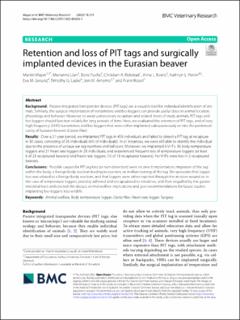| dc.contributor.author | Mayer, Martin | |
| dc.contributor.author | Lian, Marianne | |
| dc.contributor.author | Fuchs, Boris | |
| dc.contributor.author | Robstad, Christian | |
| dc.contributor.author | Evans, Alina | |
| dc.contributor.author | Perrin, Kathryn | |
| dc.contributor.author | Greunz, Eva M. | |
| dc.contributor.author | Laske, Timothy G. | |
| dc.contributor.author | Arnemo, Jon Martin | |
| dc.contributor.author | Rosell, Frank Narve | |
| dc.date.accessioned | 2022-08-25T08:07:29Z | |
| dc.date.available | 2022-08-25T08:07:29Z | |
| dc.date.created | 2022-08-11T11:44:52Z | |
| dc.date.issued | 2022 | |
| dc.identifier.citation | Mayer, M., Lian, M., Fuchs, B., Robstad, C. A., Evans, A. L., Perrin, K. L., Greunz, E. M., Laske, T. G., Arnemo, J. M. & Rosell, F. (2022). Retention and loss of PIT tags and surgically implanted devices in the Eurasian beaver. BMC Veterinary Research, 18, Artikkel 219. | en_US |
| dc.identifier.issn | 1746-6148 | |
| dc.identifier.uri | https://hdl.handle.net/11250/3013443 | |
| dc.description.abstract | Background: Passive integrated transponder devices (PIT tags) are a valuable tool for individual identification of animals. Similarly, the surgical implantation of transmitters and bio-loggers can provide useful data on animal location, physiology and behavior. However, to avoid unnecessary recapture and related stress of study animals, PIT tags and bio-loggers should function reliably for long periods of time. Here, we evaluated the retention of PIT tags, and of very high frequency (VHF) transmitters and bio-loggers that were either implanted subcutaneously or into the peritoneal cavity of Eurasian beavers (Castor fiber).
Results: Over a 21-year period, we implanted PIT tags in 456 individuals and failed to detect a PIT tag at recapture in 30 cases, consisting of 26 individuals (6% of individuals). In all instances, we were still able to identify the individual due to the presence of unique ear tag numbers and tail scars. Moreover, we implanted 6 VHFs, 36 body temperature loggers and 21 heart rate loggers in 28 individuals, and experienced frequent loss of temperature loggers (at least 6 of 23 recaptured beavers) and heart rate loggers (10 of 18 recaptured beavers). No VHFs were lost in 2 recaptured beavers.
Conclusions: Possible causes for PIT tag loss (or non-detection) were incorrect implantation, migration of the tag within the body, a foreign body reaction leading to ejection, or malfunctioning of the tag. We speculate that logger loss was related to a foreign body reaction, and that loggers were either rejected through the incision wound or, in the case of temperature loggers, possibly adhered and encapsulated to intestines, and then engulfed by the gastro-intestinal tract and ejected. We discuss animal welfare implications and give recommendations for future studies implanting bio-loggers into wildlife. | en_US |
| dc.language.iso | eng | en_US |
| dc.rights | Navngivelse 4.0 Internasjonal | * |
| dc.rights.uri | http://creativecommons.org/licenses/by/4.0/deed.no | * |
| dc.title | Retention and loss of PIT tags and surgically implanted devices in the Eurasian beaver | en_US |
| dc.type | Peer reviewed | en_US |
| dc.type | Journal article | en_US |
| dc.description.version | publishedVersion | en_US |
| dc.rights.holder | © The Author(s) 2022. | en_US |
| dc.source.volume | 18 | en_US |
| dc.source.journal | BMC Veterinary Research | en_US |
| dc.identifier.doi | https://doi.org/10.1186/s12917-022-03333-1 | |
| dc.identifier.cristin | 2042384 | |
| dc.source.articlenumber | 219 | en_US |
| cristin.ispublished | true | |
| cristin.fulltext | original | |
| cristin.qualitycode | 2 | |

